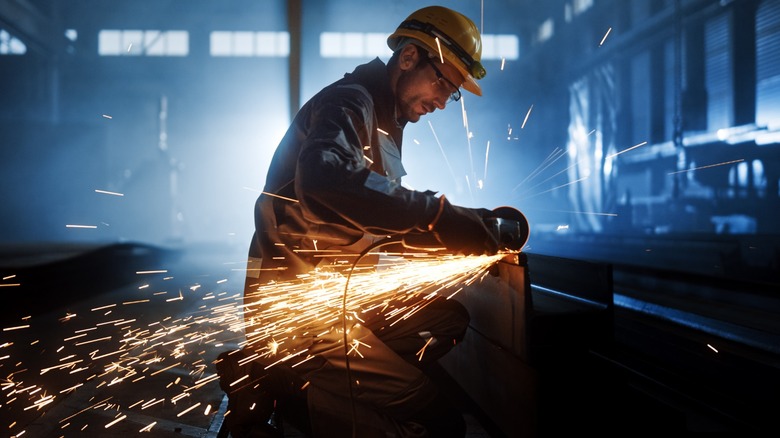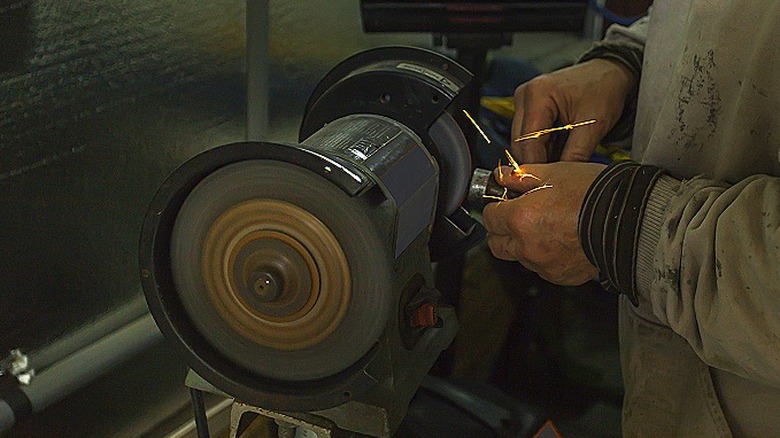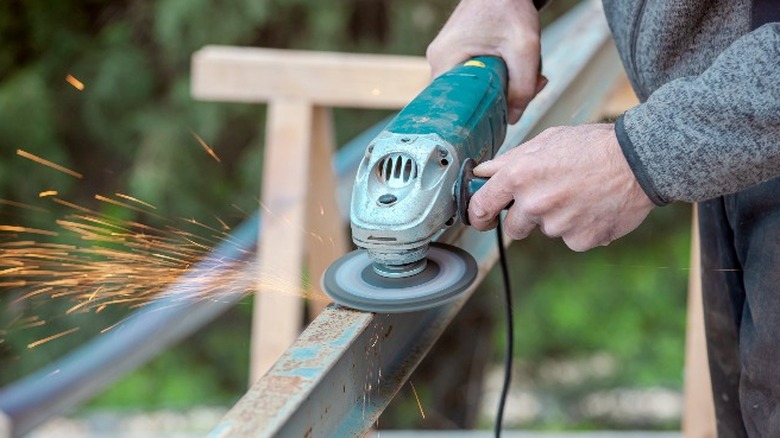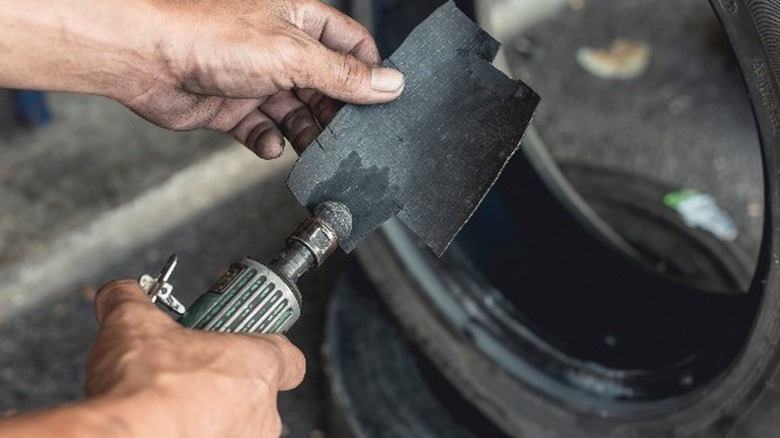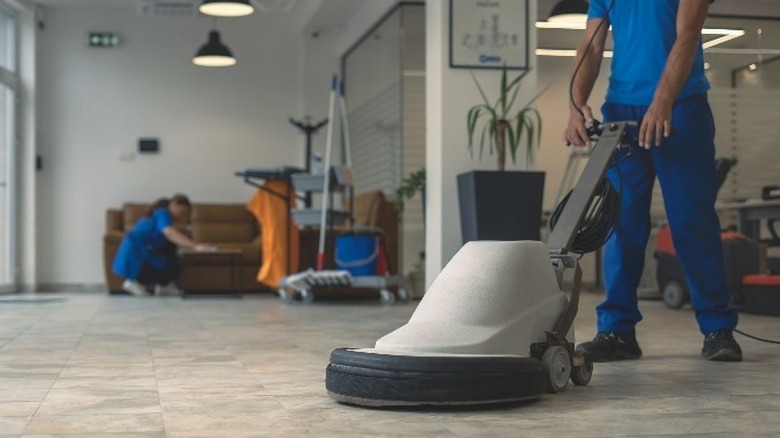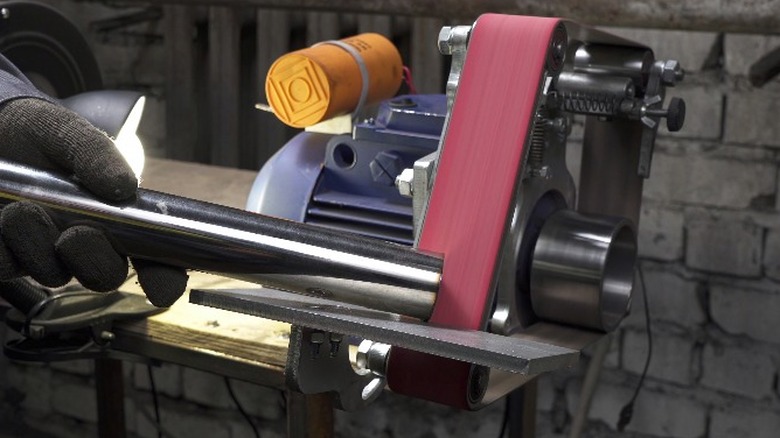5 Different Types Of Power Grinders (And When To Use Each)
Power tools come in different shapes, sizes, and applications. Grinders are no exception. Some of them look and function similarly, while others have distinct designs and extremely niche uses. At their core, all grinders are designed for grinding, cutting, polishing, and sanding. That may mean sanding a floor before treating it with a protective coating, sharpening a knife blade, or even cutting up pieces of metal for fabrication.
While all grinders have the same basic ability to cut, grind, and polish, they're not interchangeable. If you buy a belt grinder with the intention of polishing your car, you'll be out of luck. Likewise, you won't get very far trying to buff a high school gym floor with an angle grinder. It's always important to use the proper tool for the job.
But what exactly are the differences between various grinders, and how do you know when to choose one over another? Let's dive in.
Bench grinder
Bench grinders are one of the most common kinds of power grinders. Walk into any welding shop, mechanic's garage, or fabrication business, and you'll likely see at least one or two of them. Bench grinders typically mount to a table or other sturdy work surface. They can contain one or more wheels, and you'll frequently see bench grinders with one grinding wheel and one wire wheel. They also usually include guards to protect the user from sparks and flying debris, as well as a ledge where you can rest the tools or objects you're grinding. Bench grinders can contain wheels for grinding, polishing, sanding, or buffing. You may see them with wheels made from aluminum oxide or other abrasives, and you may also encounter bench grinders with soft, fluffy polishing wheels.
Bench grinders are primarily used to sand, sharpen, and polish smaller objects. You may use one to sharpen a knife, remove paint or corrosion from a piece of metal before fabrication, polish up an old tool or a bit of piping, or remove slag from a fresh weld. They're not ideal for large-scale jobs, like buffing a car or floor, but they have various applications that span industries from automotive repair and construction to custom fabrication and plumbing.
Angle grinder
Angle grinders are another extremely common type of power grinder. They're highly versatile, and you can find them in most professional and DIY toolboxes. Angle grinders can be powered by air, battery, or electricity, and they work by rapidly rotating a small wheel or disc at rates between 8,000 and 11,000 RPM. Those wheels or disks may be designed for cutting, grinding, sanding, polishing, or buffing, and you can switch between different wheels as needed. Most angle grinders also feature a side handle, which allows users to control the tool with increased precision and security.
Angle grinders are highly versatile. They have various applications and are must-have tools for numerous industries, including the automotive, construction, and fabrication trades. They're immensely popular tools for welders, mechanics, and contractors in all fields, and some of the most common uses for angle grinders include polishing cars, cutting metal, and sanding. Depending on the wheel or disk type, you can use an angle grinder to remove dust, clean up welds, cut concrete, and sharpen blades. You should choose an angle grinder for larger jobs, like buffing a car, or tasks that require more mobility, like cutting an old exhaust pipe off a vehicle.
Die grinder
Die grinders are another type of power grinder you'll frequently encounter in the toolboxes of various professionals and DIYers alike. Unlike the previous grinders covered in this list, die grinders aren't typically used to cut things. Instead, their primary purpose is to buff, grind, polish, and sand. Like rotary tools, die grinders typically feature a rotary file, abrasive disk, or polishing wheel mounted to the end of a rotating rod or spindle. However, unlike rotary tools, die grinders feature much more powerful motors and are generally used for less precise and heavier-duty applications. They're typically corded or air-powered, but you may also encounter battery-powered devices.
Die grinders are usually used to polish and grind various surfaces. You may use one with a wire wheel to clean a piece of metal before welding it, or you may use a die grinder with a sanding wheel to prep a car's body for paint. Though sometimes confused with cut-off tools, die grinders are not used for cutting. Instead, choose a die grinder if you need to polish, sand, or buff larger items. They're especially handy tools for woodworking, buffing car bodies and automotive parts, and polishing stainless steel.
Floor grinder
Floor grinders are one of the more niche tools on this list. Although they are relatively common, they're not used across as many industries as many of the other grinders discussed here. Floor grinders, as the name implies, are used to polish, buff, and sand floors. They tend to be large machines resembling vacuum cleaners but are available in various shapes and sizes. Floor grinders use large rotating disks designed for multiple tasks, and while they are usually electric, you can also find gas-powered devices, including propane varieties. Most floor grinders have handles for user control, similar to a lawn mower, while others are designed for the user to ride and drive like a small vehicle.
Floor grinders are typically used in construction but are also commonly used to polish floors in athletic facilities, schools, and other large buildings. Depending on the grinder, attachments are available for various materials and floor types, including stone and hardwood. Contractors and hobbyists may use floor grinders to remove paint and old varnish or to level an uneven floor.
Belt grinder
Belt grinders are another of the slightly more niche-oriented tools on this list. Like floor grinders, their use is widespread but crosses fewer industries than tools like an angle grinder. Belt sanders are usually powered by electricity, but they can also be pneumatic, and they work using a belt or strap attached to a motor. Belt sanders are optimal for finishing and polishing, and they allow you to swap in straps with different grit sizes depending on your needs. In comparison to bench grinders, belt grinders tend to be less abrasive and produce less heat, making them ideal for fine-tuning blades and producing exceptionally smooth surfaces.
Belt grinders are primarily used to make knives. But they have various applications, including the removal of burrs after cutting a piece of metal, finishing and polishing surfaces, and sanding. You'll want a belt grinder if you plan to do any knife-making or precise metalworking. Other potential uses for a belt grinder include jewelry polishing, carpentry, and vintage restorations.
